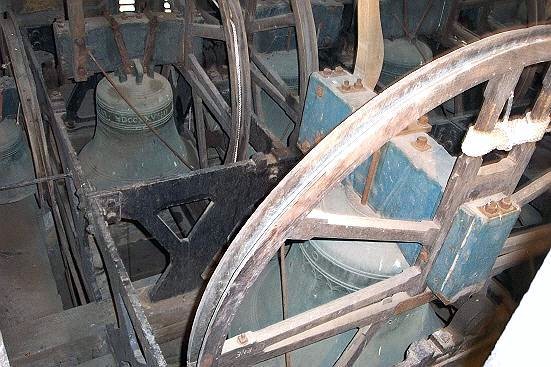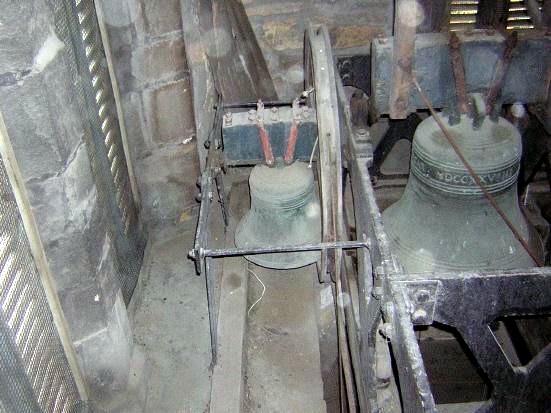|
The
organ and bells of the Abbey Church
There
has been an organ in the church since the early 19th century,
installed by John Gray in 1830 at a cost of 220 guineas, originally in the
West End gallery. The instrument was repaired and enlarged in 1848 when
the cost was met with the proceeds of a series of concerts held in Bourne,
Stamford and Peterborough on the 4th, 5th and 6th of May organised by a
church committee of 18 gentlemen from the congregation.
The location
of the organ was moved to its present position in 1870 when the organ
chamber with the vestry behind were constructed and a new instrument
installed. It was built by Gray and Davison of London and blessed at
special services on Sunday 10th July 1870. The
Stamford Mercury reported:
Two sermons were preached and
collections made after each on behalf of the new organ. In the morning,
the Rev G E Pattenden read prayers, the Vicar the lessons, and the Venerable
Archdeacon Trollope preached an eloquent sermon. In the evening, prayers
were intoned by the Rev F Roy Dowson, the Rev the Dean of Stamford read
the lessons, and a very eloquent and appropriate sermon was preached by
the Rev G E Pattenden, BD, Head Master of the Boston Grammar-school,
and Incumbent of the Chapel of Ease, Boston, to an overflowing
congregation. The church was so full that several persons sat on benches
outside the church. The organ, which is a very sweet-toned one, was ably
presided over by Mr. Shad. Frost, the organist. In the course of the
evening sermon the preacher alluded to the improvements that have been
lately made to the church, and hoped that the same good feeling would
continue to allow of other improvements being made in the fine old Abbey
church. The collections amounted to nearly £18.
The
instrument was restored in 1976 at a cost of £6,000 by Messrs Bishop & Son
of Ipswich and again in 2003, by Nicholas Pitts, of Pinchbeck, near
Spalding, Lincolnshire, when the bill was also £6,000. The money this
time was raised by parishioners who answered an appeal to sponsor
individual pipes of the instrument and the names of those who contributed
were recorded in a special book. A total of 265 pipes were paid for in
this way with donations of £4,980 while a further £1,000 was given
anonymously. The refurbishment was celebrated with a rededication of the
organ, appropriately held on St Cecilia's Day, Saturday 22nd November,
when the blessing was performed by Canon John Warwick who had retired as
vicar in 2002, in recognition of his involvement with the appeal from its
inception three years before.
The
specification of the present organ is as follows:
|
PEDAL ORGAN |
|
Grand Open Diapason
16 (1870)
Principal 8 (partly
1834)
Fifteenth 4 (from
Principal) |
Bourdon 16 (1905)
Flute 8 (from
Bourdon)
Posaunne 16 (1976) |
|
GREAT ORGAN |
|
Double Diapason 16
(1905)
Dulciana 8 (1870)
Octave 4 (1870)
Superoctave 2 (1870)
Sharp Mixture II
(1976) |
Open Diapason 8
(1870)
Stopped Diapason 8
(1870)
Flute 4 (1976)
Mixture IV (1870
& 1976)
|
|
SWELL ORGAN |
|
Clarionet Flute 8
(1870)
Vox Angelica 8
(1976)
Gemshorn 2 (1976)
Bassoon 16 (1870
& 1976)
Tremulant |
Salicional 8 (later
addition)
Principal 4 (partly
1834)
Mixture III (1976)
Cornopean 8 (1870
& 1976) |
|
Manual compass 54
notes, pedal compass 30 notes.
Couplers: Great to
pedal; Swell to Pedal; Swell to Great.
Mechanical action to
drawstops and manuals (except Great Double Diapason from Pedal).
Electro-pneumatic
action to Pedal organ (except the Grand Open Diapason). |
|
THE ORGAN TODAY
The 1870 instrument as it is today,
pictured here in August 2007 during a series of lunchtime
recitals by the organ scholar, Benedict Wilson, aged 18, to
help raise funds for the restoration appeal. Benedict played
each weekday lunchtime for 45 minutes during a six week period
as well as officiating at services. |
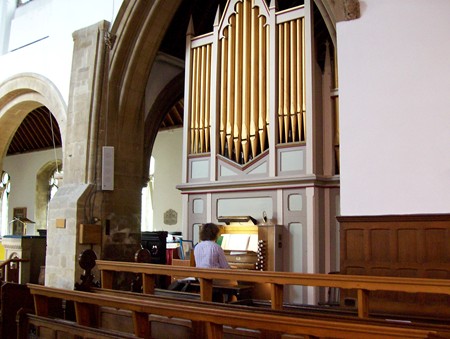 |
THE BELLS OF BOURNE ABBEY CHURCH
There is a peal of six bells
in the tower, cast in 1729 by Rudhalls of Gloucester. They were
commissioned and installed during the incumbency of the Rev William
Dodd, who was vicar from 1727-56, and whose name is inscribed on the
treble or first bell. His three churchwardens at that time were John
Hardwick, Lyon Faulkner and James Lay, and their names can be found
on the tenor or great bell in the key of G which is reckoned to
weigh 15 cwt.
|
No 1
weighing 14½ cwt: William Dodd, Vicar, 1729 Surge age (Rise and
act);
No 2
weighing 10½ cwt: 1729 Laudo Deum Verum (Praise the true God);
No 3
weighing 8 cwt: Et Clamor ad coalos, Henricus Penn, fusor 1729
(And
I call to heaven, Henry Penn, founder);
No 4
weighing 7 cwt: Ut Mundus sit nos nuno laetitiam nunc delerem 1729
(Whether
the world be joyful or doleful);
No 5
weighing 6 cwt: Plebem voco congrego clerum, Henricus Penn, fusor
(I call the people and gather the clergy, Henry Penn, founder);
No 6
weighing 15 cwt: Defunctos plange, vivos moneo (I bewail the
dead, I warn the living). John Hardwick, Lyon Faulkner and James Lay
(churchwardens).
The total
weight of the bells is 61 cwt.
NOTE:
1 cwt is 112 lb and there are 20 to the ton (avoirdupois).
|
There
was tremendous excitement in the parish when the bells were
installed and ringers were easily recruited to use them, becoming
extremely efficient in a short space of time and they soon won a
reputation for their skill in the district and were frequently called upon
to visit other churches and ring the bells. John Hurn Dove of Cawthorpe
recorded in his journal:
The
ringers of the church almost immediately became celebrated. On 19th
November 1738, they rang the first double peals in the new steeple at
Witham-on-the-Hill and on 21st February 1745, they rang the bells of
Bourne Abbey to the peals of Crown Bob (being a composition of the Oxford
Treble Bob), College Pleasure and College Treble Bob, a feat rarely
accomplished. In November 1799, the Bourne ringers were present at the
opening of the musical peal at Glinton steeple where they took a prize. On
the 1st August 1831, they won first prize at the opening of the fine-toned
new peal of bells (cast by Dobson of Downham Market, Norfolk) at Witham-on-the-Hill,
and they have since taken part at many re-openings of peals in their
immediate neighbourhood.
The
bells were completely re-hung in 1805 by Mr Cabors of Strugg's Hill,
Sutterton, Lincolnshire. His work was so well known that he was reputed to
have restored the greater part of the peals in this country and whose work
at Bourne lasted for half a century. They were partly re-hung in 1852 but
the work was carried out on the wrong principle and the vibration of the
bells had a damaging effect on the tower. A church vestry meeting was held on 27th October 1864
when a
proposal from the churchwardens, Thomas Mawby and Henry Bott, to have them
re-hung in a correct manner, was agreed. This time, the work was entrusted to the bell
founders Mears and Stainbank of London at a cost of £495, money raised by
public subscription, and was completed early in the New Year although
there were difficulties in collecting all of the money promised. The Stamford
Mercury reported on Friday 27th January 1865:
Although
the subscription recently entered into for the purpose of re-hanging these
bells has not quite reached the required amount, it is anticipated that
the result will be affected by an application which it is intended to make
to a few gentlemen who have not yet contributed to the fund.
Campanology became a passionate interest among those who participated
during the 18th and 19th centuries when visiting ringers arrived from
surrounding villages to ring the bells of the Abbey Church while the
Bourne team reciprocated with return visits, as was illustrated by this
report from the Stamford Mercury on Friday 14th January 1859:
The annual meeting for the promotion of this
science was held on Monday last. There were present, deputations from the
Maxey and other societies. Various peals were rung in first rate style.
From books kept by the ringers, it appears that ringing has flourished
here during the 130 years that have elapsed, as will be shown by extracts:
"The names of the five ringers who rung the
first double peals on the five bells in the new steeple at Witham-on-the-Hill,
November 19th, 1738: 1 Thomas Smith, 2 Robert Smith, 3 Richard Woulds, 4
Luke Hand and 5 Thomas Maxey." The old steeple had fallen on a ringing day
a year or two previous. By a singular coincidence, nearly a century
afterwards, the Bourn ringers again took a leading part in the opening of
the new peal of six bells at Witham-on-the-Hill on the first of August,
1831.
Further: "A composition of three peals called
Crown Bob, taken out of Oxford Treble Bob, College Pleasure and College
Treble Bob, without either bob or single, rung in Bourne steeple the 21st
day of February 1745-6 by these six ringers: 1 James Spence, 2 Robert
Smith, 3 Thomas Maxey, 4 Thomas Smith, 5 Edward Barnes and 6 Henry Smith."
The late Mr Charles Christopher, the elder, who
died in 1836, aged 93, learned the art with these and was for many years
the father of the present society. At this time, when so much is being
done in church restoration, and re-placing peals of bells, public
attention has been called to the state of this ancient art and it is
pleasing to record that in this district there are still many eminent
practitioners - fully equal to those of former years.
The society and their guests partook of an
excellent dinner provided by Mr William Pearce, of the Horse and Groom
Inn, and in the evening, various peals and tunes were performed on the
handbells. A meeting is arranged to take place at Market Deeping very
shortly.
The ringers at Bourne Abbey remained popular with other
churches in the neighbourhood and by this time, campanology societies
had been formed at Bourne, Maxey, Witham-on-the-Hill, Glinton and
Stamford, arranging exchange visits to ring each others bells. On
Monday 20th January 1873, the associated societies held their annual
meeting at Witham when 27 members attended and during the day several
peals were rung on the fine-toned bells of the parish church,
including Plain Bob, London Single, Oxford Treble Bob and Mr James
Dixson's celebrated peal of Bob Minor variations, accomplished in
excellent style by five ringers from the Maxey society with Mr William
Pearce from the Bourne society. At 4 pm, they all sat down to an
excellent repast provided by Mrs King of the Black Dog Inn at Witham
and the evening was agreeably passed with peals on the handbells,
singing and recitations.
The
bells at the Abbey Church were last removed in 1926 when the tower fell silent for six months
after they were taken by lorry to Croydon for re-tuning and
maintenance at Messrs Gillett and Johnson's foundry and a fund was
opened to pay for the restoration. The clappers were re-modelled and
the bells eventually re-hung on ball bearings in a dust proof housing
to make the task of ringers less arduous in the future. It was
reported at the time of their removal: "Over the years, the bells
have been put to various uses, some of their number having done duty
as the passing bell, the pancake bell, the labour bell and the curfew
bell. From time immemorial, the labour bell was rung at 6 a m in the
morning, except during December, and the curfew bell was rung every
evening
at 8 p m." Both practices which have long fallen
into disuse.
|
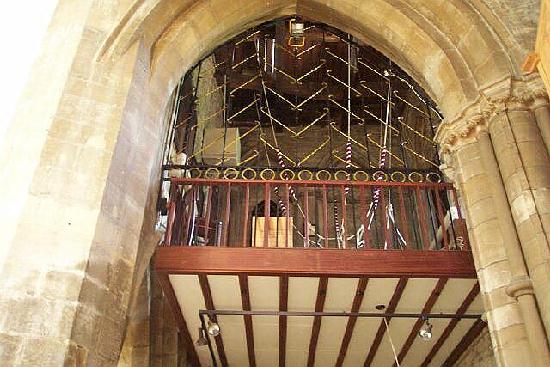 |
|
The
present ringers' gallery was installed at the Abbey Church within the south west tower in 1979.
Previously, the bells had been rung from the floor. The system was changed
to facilitate easier ringing and also to provide an exhibition and book
area for the church which now exists underneath. The work was carried out
by Messrs Bowman of Stamford to designs by Mr L H Bond. |
|
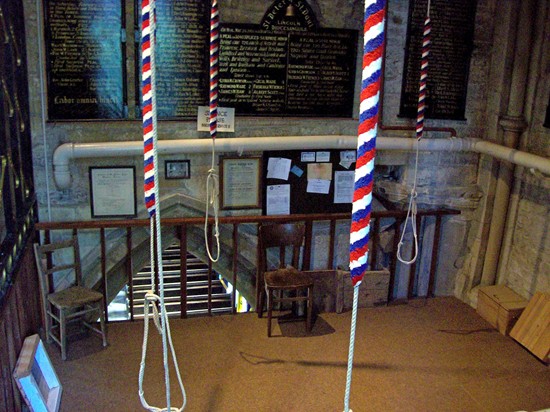 |
|
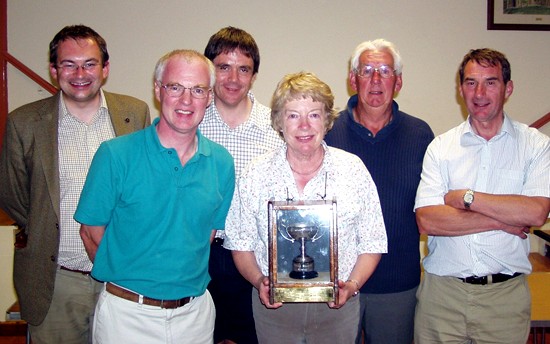 |
|
BELL RINGERS HIT THE RIGHT NOTES
The Abbey Church team of bell ringers won the
annual ringing competition held by the Lincoln Diocesan Guild in
September 2006, the first time the award has come to Bourne. The
six-member team competed at Willoughby, near Alford, against seven
other teams from all parts of the county, being judged on an
eight-minute test piece to win the silver trophy. Second place went
to Messingham with Kirton-in-Holland third. The judges said
afterwards that all three teams rang to a very high standard but
Bourne had the edge towards the end of their test piece. The team
consisted of (left to right) Matthew Payne, Jim Benner, Barry Jones,
Joan Payne, Terry Maddison and Alan Payne, the tower captain. He
said afterwards: "After being runners-up in two previous
competitions, the team deserved the top prize this year, especially
as we have been practising so hard in the past few weeks."
JUBILEE PEAL Ringers at the Abbey Church
completed a peal on Wednesday 6th June 2012 to commemorate the
Diamond Jubilee of Queen Elizabeth II. The ringers on this occasion
were No 1 bell Alan Payne (tower captain), No 2 Jim Benner, No 3
Matthew Payne, No 4 Ben Ricketts, No 5 Michael Maugham (who
conducted the peal), and No 6 Barry Jones. They began ringing at
9.35 am and completed the peal at 12.30 pm, 2 hours 55 minutes
later, a wonderful and evocative sound that could be heard quite
clearly over a mile away. OLYMPIC QUARTER
PEAL Ringers at the Abbey Church rang a
quarter peal on Friday 27th July 2012 to mark the opening of the
London Olympic Games consisting of 1,296 Surprise Minor (720 changes
of Norwich and 576 changes of Cambridge). The ringers were No 1 Jim
Benner, No 2 Joan Payne, No 3 Terry Maddison, No 4 Barry Jones, No 5
Michael Maugham and No 6 Alan G Payne (tower captain).
BRM QUARTER PEAL The ringers also
completed a quarter peal of 1,320 changes on Sunday 7th October 2012
on the occasion of the BRM Celebration Day to mark the 50th
anniversary of the locally designed and built racing car winning the
world championship title in 1962. On this occasion, a new method was
rung for the first time and this was named BRM Alliance Minor,
arranged and conducted by Barry Jones. The ringers were No 1
Joan Payne, No 2 Lois Webb, No 3 Matthew Payne, No 4 Jim Benner, No
5 Alan Payne, No 6 Barry Jones. QUEEN'S
BIRTHDAY QUARTER PEAL
A team of ringers joined the national celebrations for the Queen's
90th birthday on Sunday 12th June by ringing a quarter peal of 1,320
changes between midday and 1pm. The team, which included tower
captain Alan Payne and his son Matthew, brought together ringers
with more than two centuries experience of campanology. The event
was organised by Joan Payne.
NOTE: A peal is the name given to a particular
type of change ringing which is carried out on special occasions and
for a performance to be recognised by the Central Council for Church
Bell Ringers it
must consist of 5,040 changes which is a considerable and time
consuming feat. |
|
ROBERT LATTIMORE - 1794-1877
DEATH OF A RINGER: We have to notice this week
the death of Robert Lattimore, at the advanced age of eighty-three,
which took place on the 11th inst. He was for a great number of
years a ringer at the Abbey Church but during the past two or three
years had been too infirm to take his place in the belfry. His
remains were interred on Wednesday and in the evening a muffled peal
was rung upon the church bells. - news item from the Grantham
Journal, Saturday 17th November 1877.
THOMAS TAYLOR 1807-1889
The
second oldest known person to ring the bells at the Abbey Church was Mr
Thomas Taylor, the senior ringer, who died on Saturday 16th February
1889 at the age of 83. He had been a ringer at the church for more
than 60 years and could describe graphically events that had taken
place there and in the town for the previous 75 years. As a young
man in 1836, he was one of the pall bearers at the funeral of Lady
Catherine Digby, resident of the Red Hall and self-styled Lady of
the Manor. When Mr Taylor died, a dumb peal was rung on the bells on
the evening of his funeral.
JOHN W
LAKE 1875-1965 Many celebratory and record
peals of the bells of the Abbey Church were organised by the
well-known ringer John Lake who was team captain for many
years during the early 20th century. He also rang the bells at many
churches in the neighbourhood, believing that campanology was not
only an enjoyable pastime but also a fellowship of those who
participated. He was born into a farming family in 1875 at a cottage in
Bourne Fen and became a joiner and wheelwright, working at
Witham-on-the-Hill and Little Bytham, although during the
Great War of 1914-18, he was employed on airfield construction in
Lincolnshire. He later moved to live in South Street then West
Street, retiring when he was 69, but continued bell-ringing and with
his hobbies of wood carving and bee keeping. Mr Lake and his wife
celebrated their diamond wedding in April 1964 with a congratulatory
telegram from the Queen and he died after a long illness at the
Butterfield Hospital the following year on Thursday 7th January
1965, aged 89. |
|
The curfew
bell
Rung every night at eight o'clock (unless
Divine Service is proceeding), is a custom that has survived with
unbroken continuity, at least from Norman times. After curfew, the
date of the month is still tolled out. Its original significance,
as a warning to all to cover up their fires and retire to rest,
has long since become obsolete; although it is stated that, in
certain colonial and American towns, the custom has been
re-instituted as a caution for all young people to quit the
streets. In mediaeval times the signal was imperative, as
offenders rendered themselves liable to summary penalties. In
those far-off days, when there was little migration, and most men
died within sight of the spot where they were born, the tolling of
the sonorous bell from the gray Church tower at eventide, had an
insistent significance. To us, in an age of restless energy, the
sound falls on almost unheeding ears, as little more than a
passing note of time. It is gratifying, therefore, to know
that a custom continued throughout nearly a thousand years, is
still faithfully perpetuated.
It may not be so well known that the Abbey Church bell has been
invariably tolled early every week-day morning. This custom
appears to have come down from Saxon times, when the summons to
daily duty was known as the "labour bell" and the
imagination of the listener abed can picture how, as the sacristan
began the vibrant clang, Abbot and Monks went in silent procession
to matins in the chancel of the venerable Abbey; and how, along
the fields and fen and forest ways, Thorbrand and his brethren,
"born thralls of Colegrim or Leofric", or other local
thanes, plodded forth to labour "until the
evening".
- from Historic Bourne by Joseph J Davies,
April 1909. |
|
FROM THE ARCHIVES
An inquest was held at Bourne a few days ago by
Samuel Edwards, Gent., coroner, on the body of William Parnham, a
young man, who whilst in the act of chiming the bells for church
service on Sunday se'nnight [a week ago], fell speechless on the
belfry floor, whence he was removed to the house of his parents, and
after lingering two hours expired. Verdict, died by the visitation
of God. - news report from the Stamford Mercury, Friday 20th June
1823.
We understand that the inhabitants of Bourne
are about to erect an organ in the church of that place: upwards of
£180 has already been obtained for the purpose by voluntary
subscription but a further sum is necessary, as the contract we
believe is £225. The many recent improvements in that spirited
little place go far to prove what may be affected by unanimity; and
whilst they reflect infinite credit on the exertions of the
inhabitants, indicate well also of their prosperity. - news item
from the Stamford Mercury, Friday 1st October 1830.
ORGANIST WANTED: Wanted at Lady Day next, an
organist for Bourne Church: salary 30 guineas per annum.
Applications (if by letter to be post paid) addressed to the
Churchwardens will have immediate attention. - advertisement in
the Stamford Mercury, Friday 6th January 1832.
The members of the Abbey Church choir and the
society of ringers were entertained to supper by the vicar on the
19th and 26th ult., and on the 28th by the churchwarden of the
parish, Mr Henry Bott of the Angel Hotel. On all occasions, there
was an abundant supply of the good cheer usual at this season; and
the singing by the choir and many peals on the hand bells by the
ringers much enjoyed by the guests invited on the different
evenings. - news report from the Stamford Mercury, Friday 3rd January 1873.
On Monday evening last, a peal was rung upon
the Abbey church bells in honour of the "golden wedding" of Mr S
Benstead, clerk of the parish, that being the 50th anniversary of
his wedding day.
- news report from the Stamford Mercury, Friday 2nd November
1877.
The appointment of organist and choirmaster at
Bourne Abbey Church has been accepted by Mr Alfred E Gregory, of the
parish church, Spilsby, Mr Ruddell, the present organist, having
resigned. The future salary will be £40, which is £10 less than has
been given up to now. - news report from the Stamford Mercury,
Friday 21st December 1883. |
Return to Bourne Abbey

Go to:
Main Index Villages
Index
|

